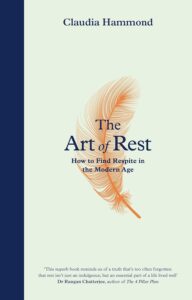 Reviewed by Canon Mike D Williams
Reviewed by Canon Mike D Williams
Do you rest enough? Busyness has become a badge of honour for some. According to her friends, Claudia Hammond is the last person they thought would write a book about rest. A psychologist who is known as a writer and broadcaster of the BBC Radio 4 All in the Mind programme. Claudia is a very busy person. She became a researcher with Durham University looking at rest that included a large-scale Rest Test survey.
This book is about the top ten activities that those people who took part in the survey found restful. At first you might think that any activity is the opposite of rest. The key point is finding an activity that you find restful – and for some being physically active is restful for their minds. Some things did not make the top ten including Claudia’s go to restful activity – gardening. Meeting family and friends was number 12 on the list so does not feature in the book.
The ten chapters start with the tenth most popular activity – mindfulness, quickly followed by watching TV. Claudia’s skill is being able to write a chapter about each activity giving background and insight from research as to why people find such an activity restful. The chapter on “doing nothing in particular” (5th most popular) is longer and more interesting than I expected. It tackles the increasing sense of value associated with busyness – if we are busy, we must be important. Sitting and doing nothing has become a challenge. Watch commuters on the train busy on their phones or laptops; no time to sit and look out of the window.
An experiment is reported where participants were asked to sit in a bare room for fifteen minutes with an electrode fitted to their ankle. There were no distractions, but they could press a key to give themselves a small electric shock. Left to their own thoughts some 71% of the men and 25% of the women gave themselves at least one shock. The pain of a shock was better than spending time with their own thoughts!
Going for a walk, listening to music, daydreaming, having a hot bath all feature. The top three in reverse order are: being alone, spending time in nature, and top of the list is reading. Perhaps nothing in the book is surprising. It was a self-selecting survey, so it is only those interested in responding that took part which skews the results.
It is a bit of a stretch to write a book about a list of ten activities but that is where the skill of the author comes to the fore. I picked up a cheap second-hand copy and certainly don’t think it is worth buying new. The take-away message is that rest is good for us. Find something that works for you and allows your brain to spend time in neutral.